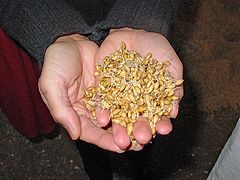Barley
| Infobox on Barley | |
|---|---|
| Example of Barley |  |
| Facts | |
| Origin | This Table shows only a selection of the most important countries of origin and should not be thought of as exhaustive
|
| Stowage factor (in m3/t) |
|
| Angle of repose | Approx. 25° (average value) |
| Humidity / moisture |
|
| Oil content | The oil content of barley is approx. 2%. |
| Ventilation | Recommended ventilation conditions: surface ventilation (see text) |
| Risk factors |
|
Barley
Contents
Description (See also Grain)
Barley is a common staple in human and animal diets. Part of the grass family, barley grows in over 100 countries and is one of the most popular cereal crops, surpassed only by wheat, corn and rice. It is currently popular in temperate areas where it is grown as a summer crop and tropical areas where it is sown as a winter crop. Its germination time is one to three days. Barley grows under cool conditions, but is not particularly winter hardy. Barley has a short growing season and is also relatively drought tolerant
Applications
It serves as a major animal fodder, a source of fermentable material for beer and certain distilled beverages, and as a component of various health foods. It is used in soups and stews, and in barley bread of various cultures. Barley grains are commonly made into malt in a traditional and ancient method of preparation.
Shipping/storage
Barley is chiefly transported as Bulk Cargo and only sometimes in bags (seed).
Humidity/Moisture
The best way of reducing the activity (respiration) of the grain and avoiding mold growth and spoilage processes is adequate pre-drying of the barley to approx. 11 - 14% moisture content.
Ventilation
At < 13% moisture contents (and RH of < 70%) barley does not need to be ventilated.
Up to moisture contents of 15%, adequate surface ventilation is advisable but not too cold to avoid damp superficial layers beneath the cargo surface. When there is a significant temperature gradient between the cargo and the external temperature, ventilation should be restricted.
Cereals loaded in a too moist condition cannot be protected from spoilage by ship's ventilation system.
Note: (Source including Transport Information Service of the GDV)











